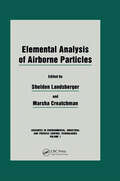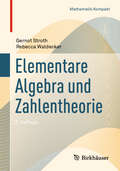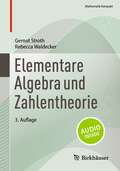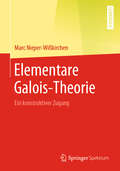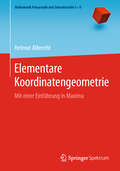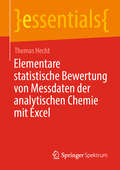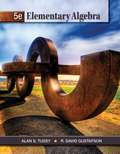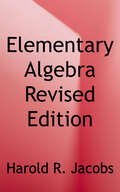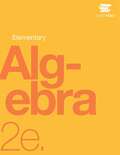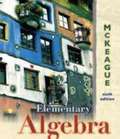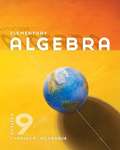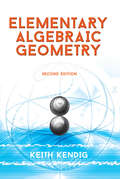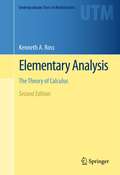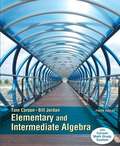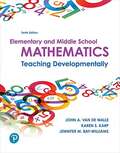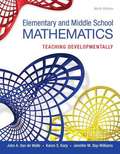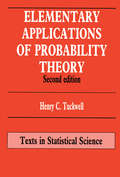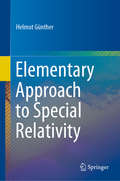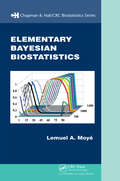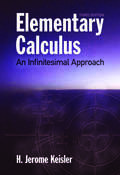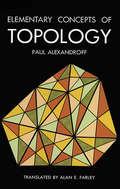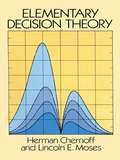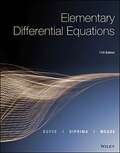- Table View
- List View
Elemental Analysis of Airborne Particles
by Sheldon Landsberger Marsha CreatchmanAn increased standard of living in developed and developing countries has brought about a distinct rise in pollution. The problem of air pollution has specifically increased the public's awareness of the environmental and health-related consequences resulting from modern day industrial technology. This detailed collection of works devoted to the most popular methods in elemental analysis of airborne particles offers investigators a comprehensive book on the most common laboratory analytical methods currently used in trace element analysis. Discussed are atomic absorption spectrometry, inductively coupled plasma, atomic emission, particle induced gamma ray analysis, particle elastic scattering and Rutherford backscattering, and neutron activation analysis. Specific sections on quality assurance/quality control and source receptor modeling have also been included.
Elementare Algebra und Zahlentheorie (Mathematik Kompakt)
by Rebecca Waldecker Gernot StrothDieses Buch behandelt die Grundlagen der Algebra und der elementaren Zahlentheorie. Zentrale Begriffe sind Primelemente und irreduzible Elemente. Ausgehend vom Aufbau einer Arithmetik in Hauptidealringen und insbesondere euklidischen Ringen sind die zentralen Themen zum einen irreduzible Polynome, zum anderen Primzahlen. Dies führt zu den algebraischen Körpererweiterungen und zu Fragen nach der Konstruktion mit Zirkel und Lineal. Nach einem längeren Ausflug in die Gruppentheorie bis zum Sylow-Satz und den auflösbaren Gruppen wird die Idee der Galoistheorie exemplarisch an der Frage der Auflösbarkeit von Polynomgleichungen behandelt. In der Zahlentheorie spielen Primzahlen eine zentrale Rolle. Behandelt werden die Verteilung von Primzahlen, Primzahlformeln, Carmichaelzahlen, Kongruenzen, der Chinesische Restsatz und quadratische Reste bis hin zum quadratischen Reziprozitätsgesetz.Neu in dieser 2. Auflage sind eine Erweiterung des Themas "Ringe" auf mehrere Kapitel sowie die Themen "Lösbarkeit von Gleichungen" und "Primzahltests“. Darüber hinaus wurden auch in einigen Beweisen andere Ideen verwendet.
Elementare Algebra und Zahlentheorie (Mathematik Kompakt)
by Rebecca Waldecker Gernot StrothDieses Buch behandelt die Grundlagen der Algebra und der elementaren Zahlentheorie. Zentrale Begriffe sind Primelemente und irreduzible Elemente. Ausgehend vom Aufbau einer Arithmetik in Hauptidealringen und insbesondere euklidischen Ringen sind die zentralen Themen zum einen irreduzible Polynome, zum anderen Primzahlen. Dies führt zu den algebraischen Körpererweiterungen und zu Fragen nach der Konstruierbarkeit mit Zirkel und Lineal. Nach einem längeren Ausflug in die Gruppentheorie bis zum Sylow-Satz und den auflösbaren Gruppen wird die Idee der Galoistheorie exemplarisch an der Frage der Auflösbarkeit von Polynomgleichungen behandelt. Zentrale Themen der Zahlentheorie sind Verteilung und Eigenschaften von Primzahlen, Primzahltests, Kongruenzen, der Chinesische Restsatz, quadratische Reste bis hin zum quadratischen Reziprozitätsgesetz und Lösungsansätze für einige diophantische Gleichungen. Neu in dieser 3. Auflage ist neben einer Erweiterung des Themas "Konstruktion mit Zirkel und Lineal", dass es begleitend zum Buch ein Audio-Angebot gibt. Die Audiodateien können im E-Book direkt durch Anklicken angehört werden, für das gedruckte Buch steht die SN More Media App zur Verfügung.
Elementare Galois-Theorie: Ein konstruktiver Zugang
by Marc Nieper-WißkirchenWarum ist die Quadratur des Kreises, warum ist die Winkeldreiteilung mit Zirkel und Lineal unmöglich? Warum gibt es allgemeine Lösungsformeln für Polynomgleichungen vom Grad 2, 3 und 4, aber nicht für Grad 5 oder höher? Dieses Lehrbuch behandelt solche klassischen Fragen elementar im Kontext der galoisschen Theorie. Es liefert somit einen klassischen Einstieg und geht dabei gleichzeitig auf Anwendungen ein. Dabei wird konsequent der Standpunkt eines konstruktiven Mathematikers eingenommen: Um die Existenz eines mathematischen Objekts zu beweisen, wird immer eine algorithmische Konstruktion dieses Objekts angegeben. Einige Aussagen sind daher etwas vorsichtiger formuliert, als es klassischerweise üblich ist; einige Beweise sind aufwändiger geführt, dafür aber klarer und nachvollziehbarer. Abstrakte Theorien und Definitionen werden aus konkreten Problemstellungen und Lösungen abgeleitet und können somit besser verstanden und gewürdigt werden. Der Stoff dieses Bandes kann im Rahmen einer einsemestrigen Vorlesung Algebra direkt zu Beginn des Mathematikstudiums behandelt werden und ist für Studienanfänger im Bachelor und Lehramt gleichermaßen geeignet. Die zentralen Aussagen werden bereits innerhalb des Textes zusammenfassend und prägnant dargestellt, der Leser wird so zum Innehalten und Reflektieren angeregt und kann Inhalte gezielt wiederholen. Darüber hinaus gibt es am Ende jedes Kapitels eine Kurzzusammenfassung, mit der noch einmal Schritt für Schritt die wesentlichen Argumente nachvollzogen werden können, sowie zahlreiche Übungsaufgaben mit ansteigendem Schwierigkeitsgrad.
Elementare Koordinatengeometrie: Mit einer Einführung in Maxima (Mathematik Primarstufe und Sekundarstufe I + II)
by Helmut AlbrechtDieses strukturell und didaktisch gut durchdachte Lehrbuch für die Ausbildung von Lehrerinnen und Lehrern im Fach Mathematik möchte den Studierenden die klassische Geometrie, die in der Schule leider ein Schattendasein fristet, unter einem etwas veränderten, neuartigen Blickwinkel nahe bringen. Von besonderem Reiz ist in diesem Zusammenhang die alte, ursprüngliche Descartes'sche Idee einer algebraischen Lösung geometrischer Probleme – ohne dabei die Geometrie durch den Formalismus der linearen Algebra und durch das Jonglieren mit Matrizen zu verdecken. Für die rechnerische Lösung der geometrischen Probleme sind nur einfache algebraische Verfahren nötig, wobei der gezielte Einsatz eines Computer-Algebra-Systems langwierige Berechnungen vermeidet und gleichzeitig die erworbenen Kenntnisse vertieft. Das Buch gibt hierfür eine praxis- und anwendungsbezogene Anleitung in den sinnvollen Gebrauch des Computer-Algebra-Systems Maxima. Eine vielfältige Aufgabensammlung rundet das Buch ab, Lösungen findet man kostenlos auf der Internetseite des Verlages.
Elementare statistische Bewertung von Messdaten der analytischen Chemie mit Excel (essentials)
by Thomas HechtDieses essential vermittelt eine zeitgemäße und praxisorientierte Einführung in die Messdatenanalyse (nicht nur) für das chemisch-analytische Labor und ermöglicht mit nur wenigen Grundlagen einen Einstieg in die Materie. Der Schwerpunkt liegt auf der Kombination von grundlegender Theorie (Mathematik) und Anwendung (Excel). Das Buch ersetzt weder ein Mathematikbuch noch einen Excel-Kurs. Vielmehr soll es dem interessierten Anwender ermöglichen, Standardaufgaben aus dem analytischen Bereich statistisch zu bewerten. Dabei wird konsequent auf den Einsatz von Excel-Funktionen bei völligem Verzicht auf VBA-Funktionen gesetzt.
Elementary Algebra
by R. David Gustafson Alan S. TussyAlgebra can be like a foreign language, but ELEMENTARY ALGEBRA, 5E, gives you the tools and practice you need to fully understand the language of algebra and the "why" behind problem solving. Using Strategy and Why explanations in worked examples and a six-step problem solving strategy, ELEMENTARY ALGEBRA, 5E, will guide you through an integrated learning process that will expand your reasoning abilities as it teaches you how to read, write, and think mathematically. Feel confident about your skills through additional practice in the text and Enhanced WebAssign. With ELEMENTARY ALGEBRA, 5E, algebra will make sense because it is not just about the x...it's also about the WHY.
Elementary Algebra
by Wade Ellis Denny BurzynskiElementary Algebra is a work text that covers the traditional topics studied in a modern elementary algebra course. It is intended for students who (1) have no exposure to elementary algebra, (2) have previously had an unpleasant experience with elementary algebra, or (3) need to review algebraic concepts and techniques.
Elementary Algebra
by Harold R. JacobsJacobs' best-selling Algebra 1 textbook has become a widely respected standard for teaching high school math in both top schools nationwide and within the homeschool market. <p><p>Jacobs' clear, engaging, conversational approach in Elementary Algebra utilizes real-world instruction and application, guiding your student towards developing a true understanding of Algebraic concepts-how they work, why they work, and how your student can apply them to everyday life!
Elementary Algebra
by John ReddenIt is essential to lay a solid foundation in mathematics if a student is to be competitive in today's global market. The importance of algebra, in particular, cannot be overstated as it is the basis of all mathematical modeling used in applications found in all disciplines. Traditionally, the study of algebra is separated into a two parts, Elementary and Intermediate Algebra. This textbook by John Redden, Elementary Algebra, is the first part written in a clear and concise manner, making no assumption of prior algebra experience. It carefully guides students from the basics to the more advanced techniques required to be successful in the next course.
Elementary Algebra
by OpenStaxElementary Algebra 2e is designed to meet scope and sequence requirements for a one-semester elementary algebra course. The book’s organization makes it easy to adapt to a variety of course syllabi. The text expands on the fundamental concepts of algebra while addressing the needs of students with diverse backgrounds and learning styles. Each topic builds upon previously developed material to demonstrate the cohesiveness and structure of mathematics. <p><p>The second edition contains detailed updates and accuracy revisions to address comments and suggestions from users. Dozens of faculty experts worked through the text, exercises and problems, graphics, and solutions to identify areas needing improvement. Though the authors made significant changes and enhancements, exercise and problem numbers remain nearly the same in order to ensure a smooth transition for faculty.
Elementary Algebra (6th Edition)
by Charles P. MckeagueAlgebra is accessible and engaging with this popular text from Charles "Pat" McKeague! ELEMENTARY ALGEBRA is infused with McKeague's passion for teaching mathematics. With years of classroom experience, he knows how to write in a way that you will understand and appreciate. McKeague's attention to detail and exceptionally clear writing style help you to move through each new concept with ease. Real-world applications in every chapter of this user-friendly book highlight the relevance of what you are learning. And studying is easier than ever with the book's multimedia learning resources, including Thomson NOW for ELEMENTARY ALGEBRA, a personalized online learning companion.
Elementary Algebra (Ninth Edition)
by Charles P. MckeagueThe book intends to improve the ability of college students, while getting them ready to make a successful start in intermediate algebra.
Elementary Algebraic Geometry: Second Edition (Dover Books on Mathematics)
by Prof. Keith KendigDesigned to make learning introductory algebraic geometry as easy as possible, this text is intended for advanced undergraduates and graduate students who have taken a one-year course in algebra and are familiar with complex analysis. This newly updated second edition enhances the original treatment's extensive use of concrete examples and exercises with numerous figures that have been specially redrawn in Adobe Illustrator. An introductory chapter that focuses on examples of curves is followed by a more rigorous and careful look at plane curves. Subsequent chapters explore commutative ring theory and algebraic geometry as well as varieties of arbitrary dimension and some elementary mathematics on curves. Upon finishing the text, students will have a foundation for advancing in several different directions, including toward a further study of complex algebraic or analytic varieties or to the scheme-theoretic treatments of algebraic geometry.2015 edition.
Elementary Analysis
by Kenneth A. RossFor over three decades, this best-selling classic has been used by thousands of students in the United States and abroad as a must-have textbook for a transitional course from calculus to analysis. It has proven to be very useful for mathematics majors who have no previous experience with rigorous proofs. Its friendly style unlocks the mystery of writing proofs, while carefully examining the theoretical basis for calculus. Proofs are given in full, and the large number of well-chosen examples and exercises range from routine to challenging. The second edition preserves the book's clear and concise style, illuminating discussions, and simple, well-motivated proofs. New topics include material on the irrationality of pi, the Baire category theorem, Newton's method and the secant method, and continuous nowhere-differentiable functions. Review from the first edition: "This book is intended for the student who has a good, but naïve, understanding of elementary calculus and now wishes to gain a thorough understanding of a few basic concepts in analysis.... The author has tried to write in an informal but precise style, stressing motivation and methods of proof, and ... has succeeded admirably." --MATHEMATICAL REVIEWS
Elementary And Intermediate Algebra (Fourth Edition)
by Bill E. Jordan Tom CarsonThe Carson Algebra Series guides students to success by presenting the why behind understanding algebra, and includes the complete Carson Math Study System with a Learning Styles Inventory to address individual learning styles. The Carson Math Study System adapts to the way each student learns, and targeted learning strategies are presented throughout the program. The authors speak to students in everyday language and walk them through the concepts, explaining not only how to do the math, but also where the concepts come from and why they work to foster conceptual understanding. Note: You are purchasing a standalone product; MyMathLab does not come packaged with this content. MyMathLab is not a self-paced technology and should only be purchased when required by an instructor. If you would like to purchase both the physical text and MyMathLab, search for: 0321951921 / 9780321951922 Elementary and Intermediate Algebra, Plus NEW MyMathLab with Pearson eText -- Access Card Package Package consists of: 0321431308 / 9780321431301 MyMathLab -- Glue-in Access Card 0321654064 / 9780321654069 MyMathLab Inside Star Sticker 0321925149 / 9780321925145 Elementary and Intermediate Algebra
Elementary And Middle School Mathematics: Teaching Developmentally
by John Van de Walle Karen Karp Jennifer Bay-WilliamsThis handy reference is particularly useful for elementary teachers who are changing grade levels and special education teachers who teach multiple grades and multiple ability levels. Guide teachers to help all PreK-8 learners make sense of mathematics Elementary and Middle School Mathematics: Teaching Developmentally illustrates how children learn mathematics, and then shows pre-service teachers the most effective methods of teaching PreK-8 math through hands-on, problem-based activities. As you engage with the activities, you'll boost your own knowledge of the math and learn concrete, developmentally appropriate ways to incorporate problem-based tasks in your classroom. Examples of real student work and new common challenges and misconception tables help you visualize good mathematics instruction and assessment that supports and challenges all learners. An important reference to consult throughout your teaching career, this book reflects the Common Core State Standards and NCTM’s Principles to Actions, as well as current research and coverage of the latest teaching technology.
Elementary And Middle School Mathematics: Teaching Developmentally
by John A. Van de Walle Karen S. Karp Jennifer M. Bay-WilliamsElementary and Middle School Mathematics: Teaching Developmentally, Professional Development Edition provides unparalleled depth of ideas and discussion to help mathematics coaches and other teacher leaders foster teachers' understanding of the mathematics they will teach and the most effective teaching methods for the various mathematics topics. This text reflects the philosophy of the NCTM and Common Core State Standards and the benefits of problem-based mathematics instruction. The Coach/Teacher Leader Guide to this Book and Activities Matrix that appear at the front of the book and Professional Learning Opportunities sections, Coach/Teacher Leader Considerations boxes, and PDToolkit boxes that appear at the end of each chapter ensure this book is a valuable resource for all educators who facilitate mathematics professional development and support students making sense of mathematics.
Elementary Applications of Probability Theory (Chapman And Hall/crc Texts In Statistical Science Ser. #32)
by Henry C. TuckwellThis book provides a clear and straightforward introduction to applications of probability theory with examples given in the biological sciences and engineering.The first chapter contains a summary of basic probability theory. Chapters two to five deal with random variables and their applications. Topics covered include geometric probability, estimation of animal and plant populations, reliability theory and computer simulation. Chapter six contains a lucid account of the convergence of sequences of random variables, with emphasis on the central limit theorem and the weak law of numbers. The next four chapters introduce random processes, including random walks and Markov chains illustrated by examples in population genetics and population growth. This edition also includes two chapters which introduce, in a manifestly readable fashion, the topic of stochastic differential equations and their applications.
Elementary Approach to Special Relativity
by Helmut GüntherThis book presents an alternative representation of Einstein's Special Theory of Relativity, which makes Special Relativity much more comprehensible. Moreover, one will come across a fundamental relationship between the Special Theory of Relativity and the mechanics of space lattice. In all previous formulations, the Einsteinian special principle of relativity, in one or the other form is used as the starting point for Special Relativity. In correspondence to this principle, one takes it as granted apriori, that all observers independent of their uniform motion to each other measure one and the same propagation velocity of a light signal. This book is thought of as a lecture for physicists, mathematicians and computer scientists and concentrates on the students of these fields. The book should reach a broad circle of interested readers from the fields of natural sciences and philosophy and provide and invigorating experience for engineers.
Elementary Bayesian Biostatistics (Chapman & Hall/CRC Biostatistics Series)
by Lemuel A. MoyeBayesian analyses have made important inroads in modern clinical research due, in part, to the incorporation of the traditional tools of noninformative priors as well as the modern innovations of adaptive randomization and predictive power. Presenting an introductory perspective to modern Bayesian procedures, Elementary Bayesian Biostatistics explo
Elementary Calculus: An Infinitesimal Approach (Dover Books on Mathematics)
by H. Jerome KeislerThis first-year calculus book is centered around the use of infinitesimals, an approach largely neglected until recently for reasons of mathematical rigor. It exposes students to the intuition that originally led to the calculus, simplifying their grasp of the central concepts of derivatives and integrals. The author also teaches the traditional approach, giving students the benefits of both methods.Chapters 1 through 4 employ infinitesimals to quickly develop the basic concepts of derivatives, continuity, and integrals. Chapter 5 introduces the traditional limit concept, using approximation problems as the motivation. Later chapters develop transcendental functions, series, vectors, partial derivatives, and multiple integrals. The theory differs from traditional courses, but the notation and methods for solving practical problems are the same. The text suggests a variety of applications to both natural and social sciences.
Elementary Concepts of Topology
by Paul AlexandroffAlexandroff's beautiful and elegant introduction to topology was originally published in 1932 as an extension of certain aspects of Hilbert's Anschauliche Geometrie. The text has long been recognized as one of the finest presentations of the fundamental concepts, vital for mathematicians who haven't time for extensive study and for beginning investigators.The book is not a substitute for a systematic text, but an unusually useful intuitive approach to the basic concepts. Its aim is to present these concepts in a clear, elementary fashion without sacrificing their profundity or exactness and to give some indication of how they are useful in increasingly more areas of mathematics. The author proceeds from the basics of set-theoretic topology, through those topological theorems and questions which are based upon the concept of the algebraic complex, to the concept of Betti groups which binds together central topological theories in a whole and upon which applications of topology largely rest.Wholly consistent with current investigations, in which a larger and larger part of topology is governed by the concept of homology, the book deals primarily with the concepts of complex, cycle, and homology. It points the way toward a systematic and entirely geometrically oriented theory of the most general structures of space.First English translation, prepared for Dover by Alan E. Farley. Preface by David Hilbert. Author's Foreword. Index. 25 figures.
Elementary Decision Theory (Dover Books on Mathematics)
by Lincoln E. Moses Herman Chernoff"The text is very clearly written [with] many illustrative examples and exercises [and] should be considered by those instructors who would like to introduce a more modern (and a more logical) approach in a basic course in statistics." --Journal of the American Statistical AssociationThis volume is a well-known, well-respected introduction to a lively area of statistics. Professors Chernoff and Moses bring years of professional expertise as classroom teachers to this straightforward approach to statistical problems. And happily, for beginning students, they have by-passed involved computational reasonings which would only confuse the mathematical novice.Developed from nine years of teaching statistics at Stanford, the book furnishes a simple and clear-cut method of exhibiting the fundamental aspects of a statistical problem. Beginners will find this book a motivating introduction to important mathematical notions such as set, function and convexity. Examples and exercises throughout introduce new topics and ideas.The first seven chapters are recommended for beginning courses in the basic ideas of statistics and require only a knowledge of high school math. These sections include material on data processing, probability and random variables, utility and descriptive statistics, uncertainty due to ignorance of the state of nature, computing Bayes strategies and an introduction to classical statistics. The last three chapters review mathematical models and summarize terminology and methods of testing hypotheses. Tables and appendixes provide information on notation, shortcut computational formulas, axioms of probability, properties of expectations, likelihood ratio test, game theory, and utility functions.Authoritative, yet elementary in its approach to statistics and statistical theory, this work is also concise, well-indexed and abundantly equipped with exercise material. Ideal for a beginning course, this modestly priced edition will be especially valuable to those interested in the principles of statistics and scientific method.
Elementary Differential Equations
by William E. Boyce Richard C. DiPrimaElementary Differential Equations, 11th Edition is written from the viewpoint of the applied mathematician, whose interest in differential equations may sometimes be quite theoretical, sometimes intensely practical, and often somewhere in between. <p><p>The authors have sought to combine a sound and accurate (but not abstract) exposition of the elementary theory of differential equations with considerable material on methods of solution, analysis, and approximation that have proved useful in a wide variety of applications. While the general structure of the book remains unchanged, some notable changes have been made to improve the clarity and readability of basic material about differential equations and their applications. <p><p> In addition to expanded explanations, the 11th edition includes new problems, updated figures and examples to help motivate students. The program is primarily intended for undergraduate students of mathematics, science, or engineering, who typically take a course on differential equations during their first or second year of study. The main prerequisite for engaging with the program is a working knowledge of calculus, gained from a normal two or three semester course sequence or its equivalent. Some familiarity with matrices will also be helpful in the chapters on systems of differential equations.
